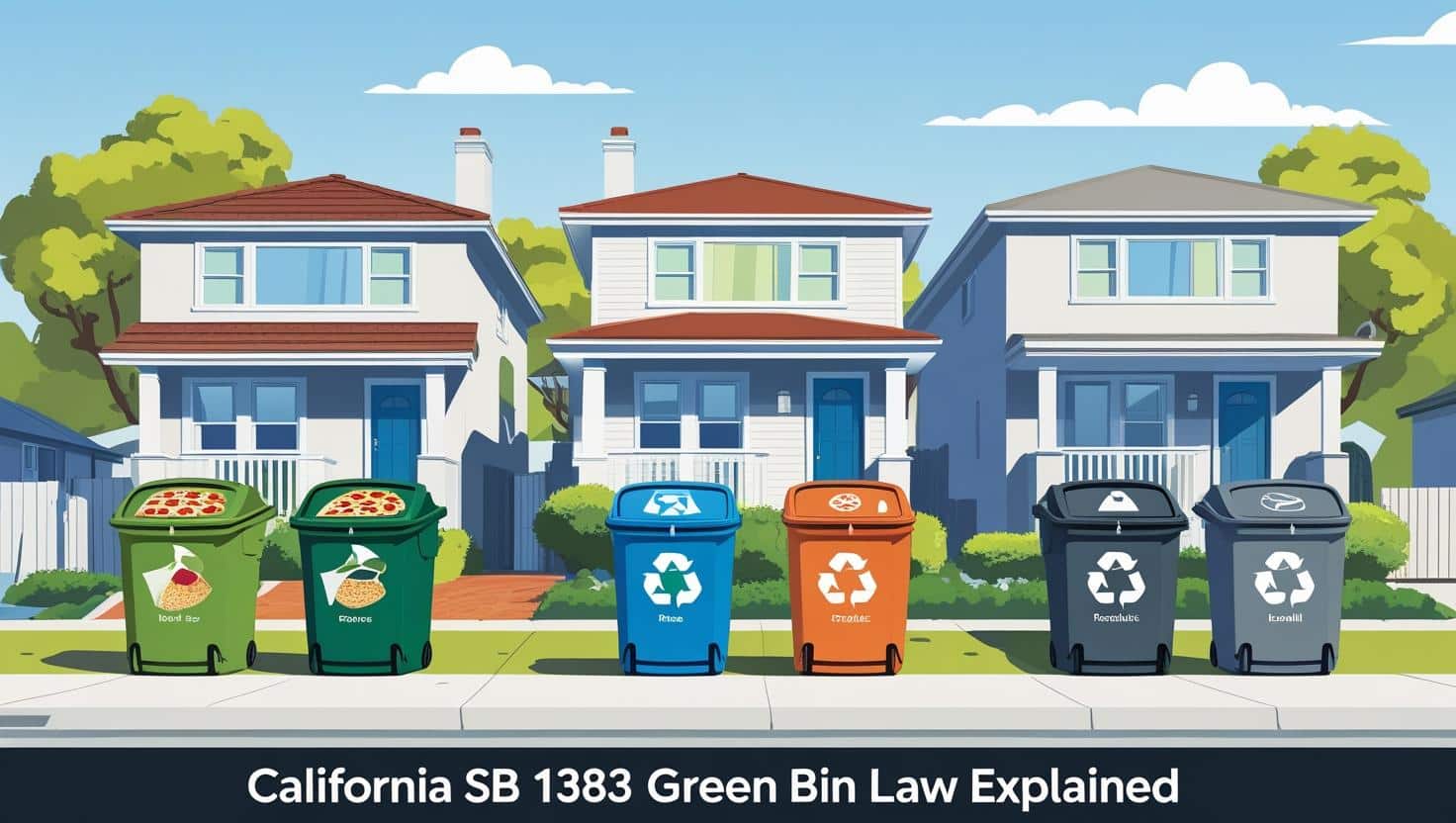“Does this pizza box go in the green bin or the blue bin?”
If you’ve had that debate at home, you’re not alone. From roommates in Los Angeles to families in Sacramento, Californians are constantly puzzled about where their trash really belongs. The root of this everyday kitchen confusion is the California SB 1383 Green Bin Law.
This statewide law, passed in 2016 and rolled out in recent years, requires everyone to separate food scraps, yard waste, and even food-soiled paper into the green composting bin. The goal is big: cut down methane from landfills and keep 75% of organic waste out of the trash by 2025. Sounds simple, right? Yet in real life, questions pile up—Can meat and bones go in? What about coffee grounds or greasy pizza boxes? And will you actually get fined if you mess up?
The California SB 1383 Green Bin Law has sparked arguments, confusion, and even neighborly complaints. But it’s not just about rules and fines—it’s about climate action. In this article, we’ll clear up the confusion, explain what goes where, highlight how cities enforce the law, and share practical tips to make your green bin routine easier.
By the end, you’ll know exactly what to do with that pizza box—and avoid any surprise fines along the way.
What Is the California SB 1383 Green Bin Law?
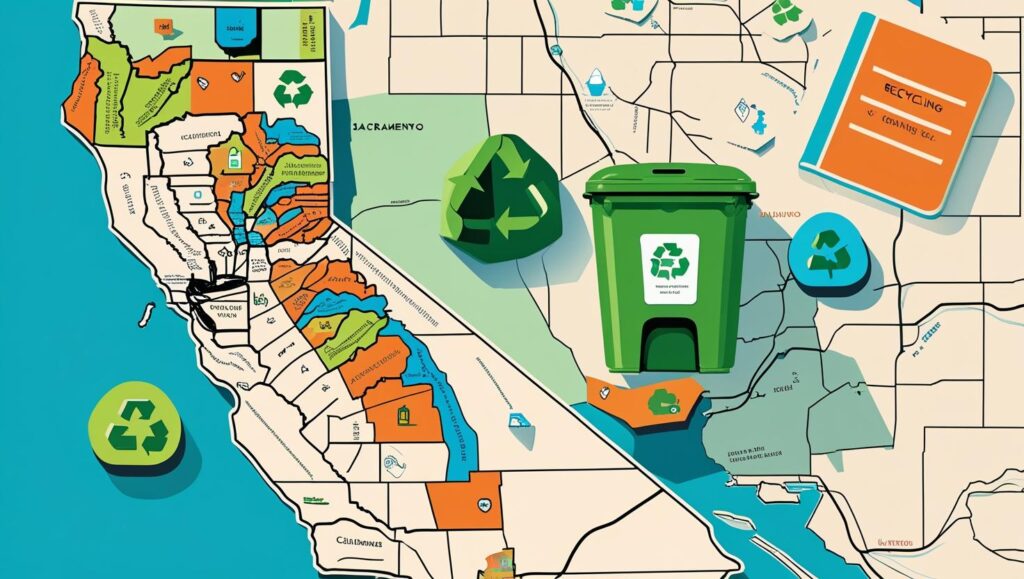
At its core, California Senate Bill 1383—better known as SB 1383—is the state’s organics recycling mandate. The law was passed back in 2016, but it didn’t go into full effect overnight. Instead, the rollout happened in stages:
- 2016 – Law officially signed to target short-lived climate pollutants like methane.
- 2022 – Statewide rollout began, requiring residents and businesses to separate food scraps and yard waste into green bins.
- 2024 – Cities gained the authority to issue fines for non-compliance, though most still focus on education first.
The purpose behind SB 1383 is much bigger than sorting trash—it’s climate protection. When food and other organic waste break down in landfills, they release methane, a greenhouse gas over 80 times more powerful than carbon dioxide in the short term. To fight this, California set an ambitious goal: divert 75% of organic waste away from landfills by 2025. That means billions of pounds of food scraps, napkins, and yard trimmings that once went to the dump now need to find their way into composting facilities instead.
Enforcement of the SB 1383 California requirements is handled by CalRecycle, the state agency responsible for recycling laws, along with individual cities and counties. In practice, this means your local waste hauler may check bins for contamination, while city programs provide guidance, kitchen caddies, or even warning notices if you’re not following the rules.
In short, the SB 1383 organics recycling mandate is California’s way of turning every household into part of the climate solution—one banana peel, pizza box, and yard clipping at a time.
Why Is SB 1383 Such a Big Deal? (Climate & Everyday Impact)
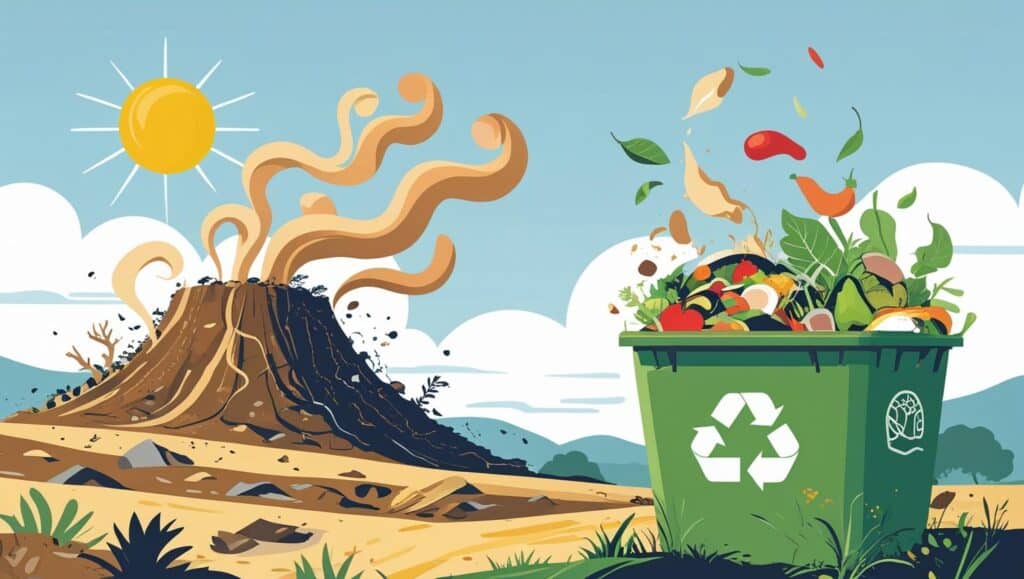
On the surface, SB 1383 might look like just another recycling rule. But in reality, it’s one of California’s most ambitious climate policies. Why? Because food scraps and yard waste aren’t just harmless trash—they’re a major source of methane when dumped in landfills.
Methane is what scientists call a short-lived climate pollutant. It doesn’t linger in the atmosphere as long as carbon dioxide, but it traps heat far more powerfully—over 80 times stronger in the near term. Landfills are among California’s largest sources of methane emissions, and that’s where the organic waste law California comes in. By keeping food and other organics out of landfills, SB 1383 is designed to deliver fast, meaningful climate benefits.
The scale of the problem is huge: more than 20% of California’s trash is organic waste. Think about every apple core, half-eaten sandwich, coffee filter, and lawn clipping that gets tossed daily. When you multiply that by 39 million people, the numbers quickly add up. Without change, all of that organic matter sits in dumps, rotting and releasing methane straight into the air.
This is why SB 1383 isn’t just about cities, businesses, or waste companies—it’s about residents. Everyday compliance is critical. Every banana peel that goes into the green bin instead of the gray landfill bin is a small act of climate action. And when millions of households do it together, the impact becomes massive.
In short, SB 1383 is a big deal because it connects your kitchen trash to California’s fight against climate change. It transforms the simple act of tossing leftovers into something much bigger: protecting the planet’s future.
How the 3-Bin System Works Under SB 1383
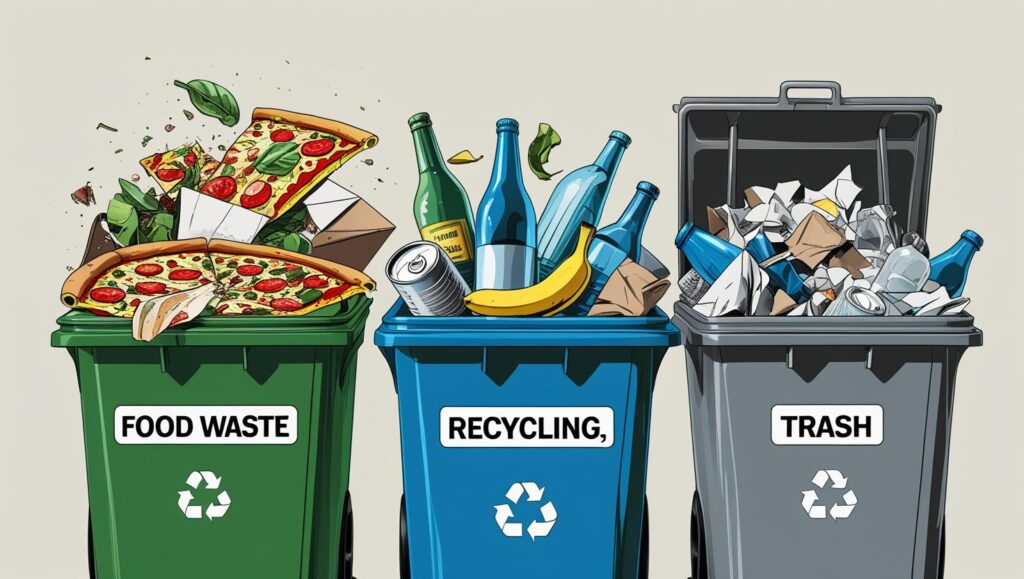
California’s 3-bin system is the backbone of SB 1383. To make sure organic waste gets composted instead of dumped, the state standardized bin colors so that no matter where you live, the rules look familiar. Here’s how it works:
The Green Bin – Food Scraps & Yard Waste
This is the star of the new law. The green bin is where all food scraps and organic waste go, including:
- Fruits and vegetables
- Meat, poultry, and fish (yes, even bones)
- Eggshells and dairy scraps
- Coffee grounds and tea bags
- Yard trimmings like grass, leaves, and branches
- Food-soiled paper such as greasy pizza boxes, napkins, and paper towels
👉 FAQ: Can meat & bones go in the green bin?
Yes! Under SB 1383, meat, bones, and even leftover pizza crusts belong in the green bin. Many people assume these should go in the landfill, but the composting facilities are designed to handle them safely.
So if you’re ever debating, “Does this pizza box go in the green bin?,” the answer is yes—as long as it’s food-soiled. Clean cardboard should go into the recycling bin instead.
The Blue Bin – Recyclables
The blue bin hasn’t changed much, but SB 1383 makes it extra important to avoid contamination. This is where clean recyclables belong, such as:
- Glass bottles and jars
- Metal cans (aluminum, tin, steel)
- Clean paper and cardboard
- Plastic bottles and containers (check local rules for recycling numbers)
What does not belong here? Anything with food or grease. For example, a shiny soda can goes in blue, but a greasy napkin belongs in green. Mixing the two can cause contamination that ruins an entire batch of recycling.
The Gray Bin – Landfill
Finally, the gray bin is the “last resort.” Only items that cannot be recycled or composted should end up here, such as:
- Plastic bags and wrappers
- Diapers and sanitary products
- Styrofoam packaging
- Broken glass or ceramics
The goal is to shrink what goes into gray bins as much as possible. Thanks to SB 1383, most household waste should now be going into either green or blue.
The California 3-bin system colors—green for organics, blue for recyclables, and gray for landfill—are designed to make sorting simple. Once you remember the color code, everyday trash decisions get a lot easier.
Everyday Green Bin Confusion in California Kitchens
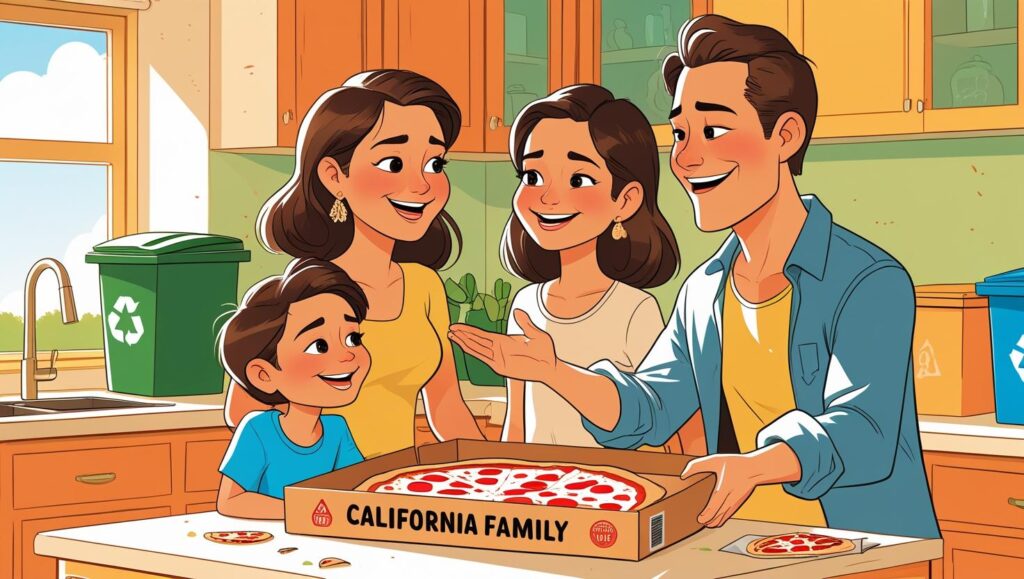
Even though the 3-bin system sounds straightforward, California kitchens often tell a different story. Families, roommates, and neighbors still argue over the “right bin,” and some of the most common debates have become legendary.
The “Pizza Box Debate”
It usually starts with a simple question: “Blue bin or green bin?” One person swears a greasy pizza box should go in recycling because it’s cardboard. Another argues it belongs in the compost bin because of the cheese stains. Before you know it, you’ve got a full-blown kitchen standoff.
Here’s the official answer: clean cardboard = blue bin. Greasy, food-soiled cardboard = green bin. So yes, that late-night pizza box with oil spots goes in the green bin. Many households in California have learned this lesson the hard way—sometimes after a roommate or family member digs it out of the wrong bin with a sigh.
Coffee Grounds, Paper Towels, and Napkins
Morning coffee creates its own mini-drama. People wonder: does the filter go in blue, green, or gray? The truth is simple—coffee grounds, filters, napkins, and paper towels all belong in the green bin if they’re food-soiled. A clean paper towel used to dry your hands goes in blue (recycling), but one used to wipe spaghetti sauce? Straight to the green bin.
Plastic Bags and Compostable Liners
Perhaps the trickiest part of the green bin is what you’re not supposed to use. Regular plastic bags are not compostable and should never go in the green bin. Some cities do allow special compostable liners, but they must be compostable bags BPI certified California. Look for the BPI logo before buying.
This is one of the most important green bin do’s and don’ts. Do use approved compostable liners or paper bags to keep your bin cleaner. Don’t toss in regular plastic bags—they can contaminate entire loads of compost and end up sending good material back to the landfill.
In the end, these kitchen debates might seem silly, but they highlight the everyday learning curve of SB 1383. Once you know the rules, you’ll spend less time arguing over bins—and more time enjoying that pizza.
SB 1383 Fines, Enforcement, and Warnings
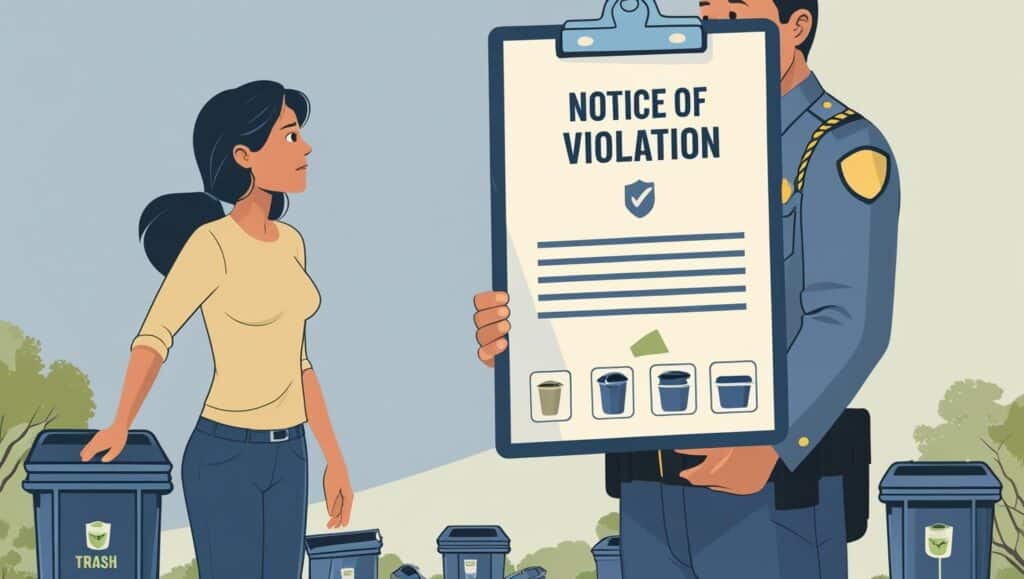
Whenever Californians first hear about SB 1383, their immediate worry is: “Am I going to get fined if I toss something in the wrong bin?” The short answer is—yes, technically. But the reality is more about education than punishment. Let’s break it down.
Do Californians Really Get Fined?
Under the law, cities and counties are authorized to issue fines for non-compliance. That means if you consistently misuse your bins, you could face SB 1383 fines for residents.
But here’s the catch: most local governments don’t want to punish right away. Instead, they’re focused on education, outreach, and giving residents time to adjust. Actual SB 1383 enforcement and penalties usually come later—and only after repeated violations.
How Much Are the Fines?
The maximum penalty under SB 1383 can be steep. Depending on the city, fines range from $50 for a first violation up to $500 for repeat offenses. This is often referred to as the green bin contamination fine amount, since most tickets are issued when residents toss the wrong materials into the wrong bin.
Think of it this way: one greasy pizza box in the blue bin won’t cost you. But a repeated pattern of contamination might.
Warnings Before Tickets
In most cities, fines don’t happen overnight. Instead, residents receive a “notice of violation” or written warning first. These warnings explain what went wrong and how to fix it.
That’s why it’s more accurate to think of SB 1383 as “warn first, fine later.” The system is built to encourage compliance, not to punish. If you’ve heard stories of $500 tickets landing after one mistake, that’s more myth than reality.
Who Checks Your Bin?
Enforcement isn’t random—waste haulers and city contractors perform routine SB 1383 container monitoring. This often happens during curbside pickup, when drivers can spot obvious contamination (like plastic bags in the green bin). Some cities even do “lid flips,” where inspectors take a quick peek to ensure residents are sorting correctly.
The goal isn’t to snoop, but to make sure bins are used as intended. After all, one wrong item can contaminate a whole truckload of compost.
In short: yes, fines exist, but they’re the last step, not the first. SB 1383 is designed to guide Californians toward better habits—warnings and education come before penalties.
City-by-City Examples of SB 1383 Enforcement
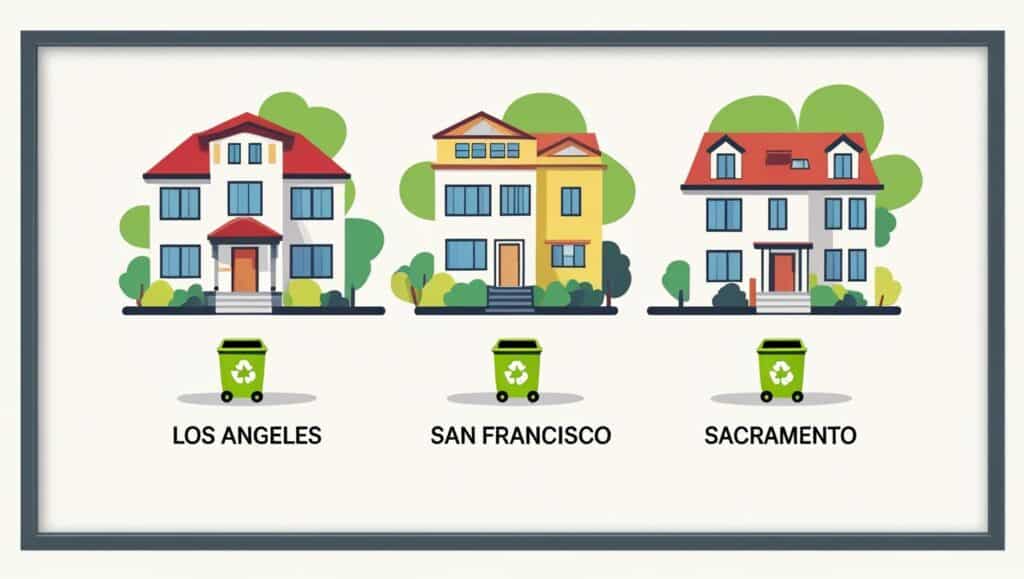
While SB 1383 is a statewide law, its day-to-day enforcement often depends on local governments. Each California city has adopted slightly different systems to help residents adapt. Here’s how three major cities—Los Angeles, San Francisco, and Sacramento—are putting the law into practice.
Los Angeles (OrganicsLA Program)
In Los Angeles, the rollout of SB 1383 happened through the OrganicsLA program, one of the largest organics recycling efforts in the country. To help residents comply, the city distributed free kitchen pails (small countertop containers) so households can easily collect food scraps before transferring them to the outdoor green bin.
The rules are clear: food scraps, yard waste, and food-soiled paper all belong in the green bin. This includes pizza boxes, napkins, and leftovers—items that used to confuse people the most. By offering education materials in multiple languages and providing tools like pails, the city makes it easier for households to follow the Los Angeles green bin rules SB 1383.
San Francisco
San Francisco is no stranger to composting. In fact, the city has required residents and businesses to separate food scraps and recyclables since 2009—long before SB 1383 came into effect. That means compliance rates were already high when the statewide law kicked in.
Instead of reinventing the wheel, SB 1383 simply strengthened existing composting rules in the city. Residents still separate organics into the green bin, recyclables into the blue, and landfill waste into black. What’s new is that the state now monitors progress toward climate goals, which reinforces San Francisco’s leadership role in sustainability. Put simply, San Francisco SB 1383 organics requirements don’t feel new—but they validate the city’s pioneering approach.
Sacramento
Sacramento, the state’s capital, also launched its organics recycling program to comply with SB 1383. Every household now has an organics cart, which serves as the designated green bin for food scraps, yard waste, and food-soiled paper.
The city has emphasized outreach, making sure residents understand what belongs inside the cart and what doesn’t. For example, banana peels and chicken bones go in, but plastic bags and Styrofoam do not. Educational mailers, cart labels, and neighborhood workshops have been used to help residents follow the Sacramento organics cart rules without confusion.
Together, these city-by-city examples show that while SB 1383 is a statewide mandate, its implementation is highly local. From free countertop caddies in Los Angeles to long-standing composting traditions in San Francisco and organized outreach in Sacramento, each community has its own way of bringing the law to life.
SB 1383 and Apartments / Multi-Family Housing

One of the most challenging parts of SB 1383 compliance is in apartments and multi-family housing communities. Unlike single-family homes where residents have their own bins, apartment complexes usually share large dumpsters or cart stations. This makes it harder to keep organic waste separated correctly.
Under SB 1383 apartment rules, landlords and property managers must:
- Provide clearly labeled organic waste bins (for food scraps, yard trimmings, and soiled paper).
- Offer regular education to tenants about what goes in each bin.
- Ensure bins are placed in accessible locations so residents don’t ignore them.
Many HOAs (Homeowners Associations) and multi-unit complexes face confusion because residents often mix trash, recycling, and compost in shared containers. This contamination not only violates California composting laws but can also lead to higher collection costs.
To solve this, cities encourage HOAs and landlords to:
- Use signage with pictures (helpful for non-English speakers).
- Conduct short orientation sessions for new tenants.
- Appoint a “green ambassador” or volunteer resident to monitor bins.
Ultimately, the goal is to make composting just as easy as throwing something in the trash. With the right SB 1383 education and infrastructure, even large apartment communities can comply without much hassle.
♻️ Edible Food Recovery Requirement (SB 1383’s Hidden Part)
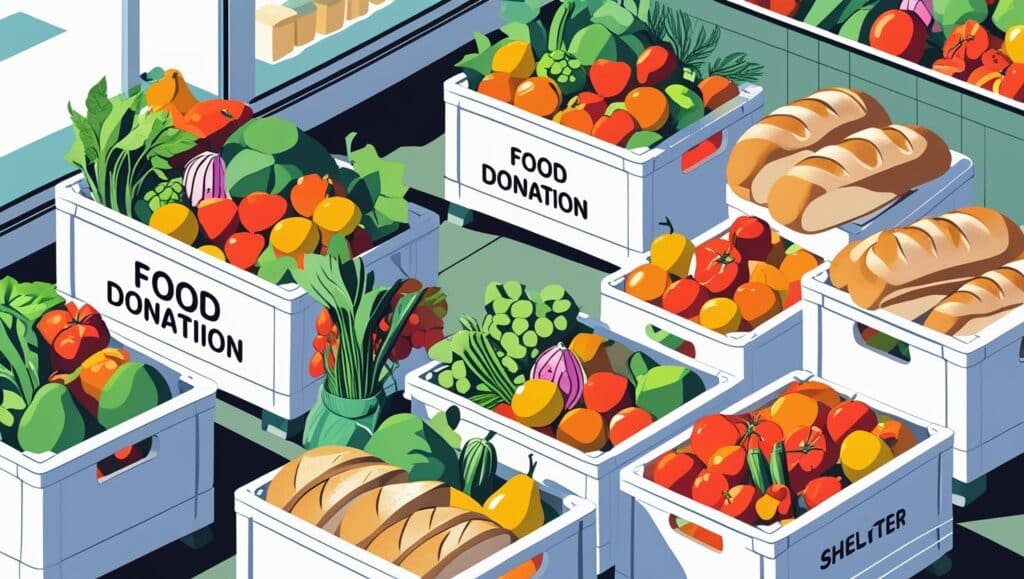
Most people think SB 1383 is only about separating food scraps from trash bins. But here’s the hidden (and very important) part — edible food recovery.
Under food donation requirements SB 1383, large businesses (like grocery stores, wholesale food vendors, and supermarkets) can’t just throw away unsold yet perfectly good food anymore. Instead, they must donate it to food recovery organizations, food banks, or charities.
👉 The target? By 2025, California must recover 20% of all edible food that would have otherwise been wasted and redirect it to people in need.
This means:
- Less landfill waste ✅
- Fewer greenhouse gases ✅
- More meals for hungry families ✅
In short, SB 1383 is not just about waste diversion, it’s also about social good — connecting surplus food with communities that need it most.
Practical Tips to Make the Green Bin Less Painful
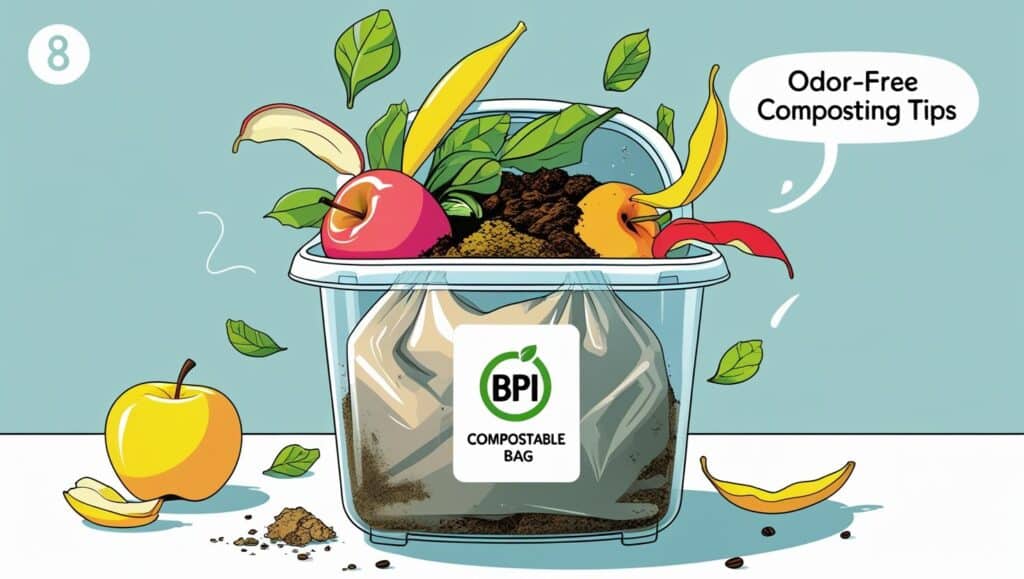
Let’s be real—while the green bin is great for the planet, it can sometimes feel like a bit of a hassle at home. Smells, fruit flies, sticky messes—it all adds up. But don’t worry, with a few smart strategies you can make your green bin experience much easier (and way less gross).
How to Control Smell & Pests
One of the biggest complaints people have is the odor and pests that come with food scraps. The good news? A few small habits can go a long way.
- Freeze food scraps: Instead of tossing everything directly into the bin, keep a small container in your freezer. Onion peels, meat scraps, and other smelly items won’t stink up your kitchen if they’re frozen until bin collection day.
- Line with newspaper: If you don’t want to use compostable bags all the time, old newspapers make an excellent liner. They soak up moisture and help reduce smells.
- Rinse and clean weekly: Give your bin a quick rinse with mild soap and water after each collection. A clean bin = fewer pests and much less odor.
These simple green bin odor and pests tips can help keep your kitchen (and your nose) much happier while still doing your part for the environment.
Using a Kitchen Countertop Caddy
If you live in California (or many other states), your city might actually give you a free kitchen countertop caddy to collect daily scraps. These small containers make it super convenient—you just drop in your food waste, and when it’s full, you empty it into the bigger outdoor green bin.
If your city doesn’t provide one, you can easily buy a kitchen countertop caddy California style online. Look for caddies with a tight-fitting lid and ventilation filters to reduce smell and keep fruit flies away. Some even have sleek designs that blend right in with modern kitchens.
Best Compostable Bags to Use
While you don’t always need a bag, many people find them helpful to keep things neat and tidy. Just make sure you’re using BPI-certified compostable bags—they’re tested and approved to break down properly in municipal composting systems.
Avoid so-called “biodegradable” or “oxo-degradable” plastics, since they often don’t compost fully and can contaminate the process. Stick with trusted brands that carry the BPI logo, and you’ll make your green bin routine a whole lot cleaner and simpler.
🗑️ Common Myths About the Green Bin (Busted)
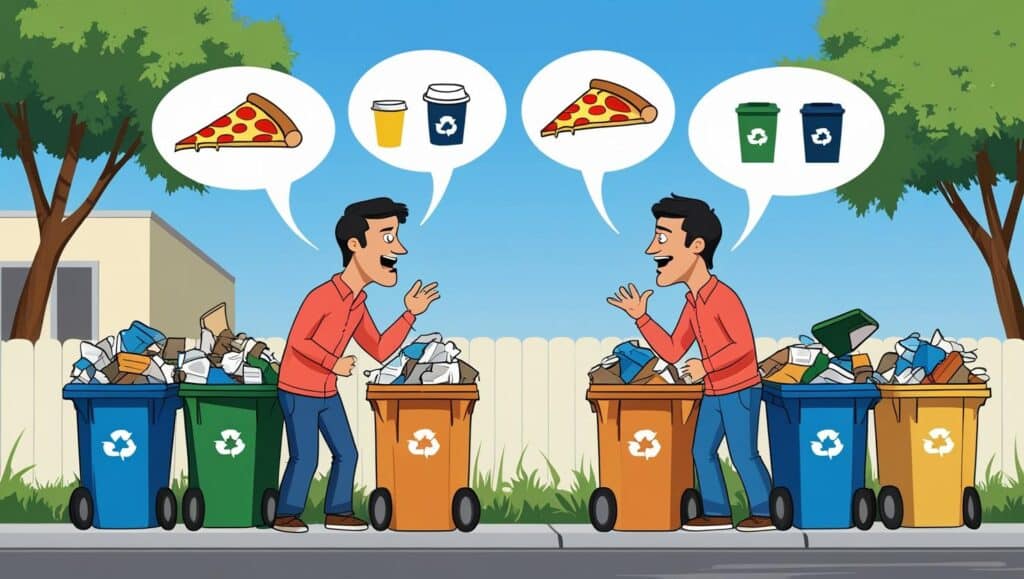
Many people avoid using the green bin because they’ve heard rumors or half-truths about it. Let’s clear up the confusion and bust some common myths:
❌ Myth 1: “I’ll always get fined if I make a mistake”
✅ Reality: Nope! Cities don’t want to punish you right away. In most places, if you put the wrong item in your green bin, you’ll usually get a warning first. This might be a sticker on your bin or a note telling you what went wrong. Fines are usually the last step if someone keeps repeating mistakes.
❌ Myth 2: “Pizza boxes are trash”
✅ Reality: Greasy pizza boxes actually belong in the green bin. The oil and food stains make them non-recyclable, but they’re perfect for composting. So, next time you finish your pizza night, toss the box in the green bin with pride 🍕.
❌ Myth 3: “Any plastic bag is okay”
✅ Reality: Not all plastic bags break down in compost. Only certified compostable bags (they usually have a logo or label) are allowed. Regular plastic bags contaminate the whole batch of compost and can cause the bin to be rejected. If you don’t have compostable bags, you can line your bin with newspaper instead.
👉 Bottom line: The green bin is easier and more forgiving than most people think. Don’t let myths stop you from using it!
FAQs (People Also Ask)
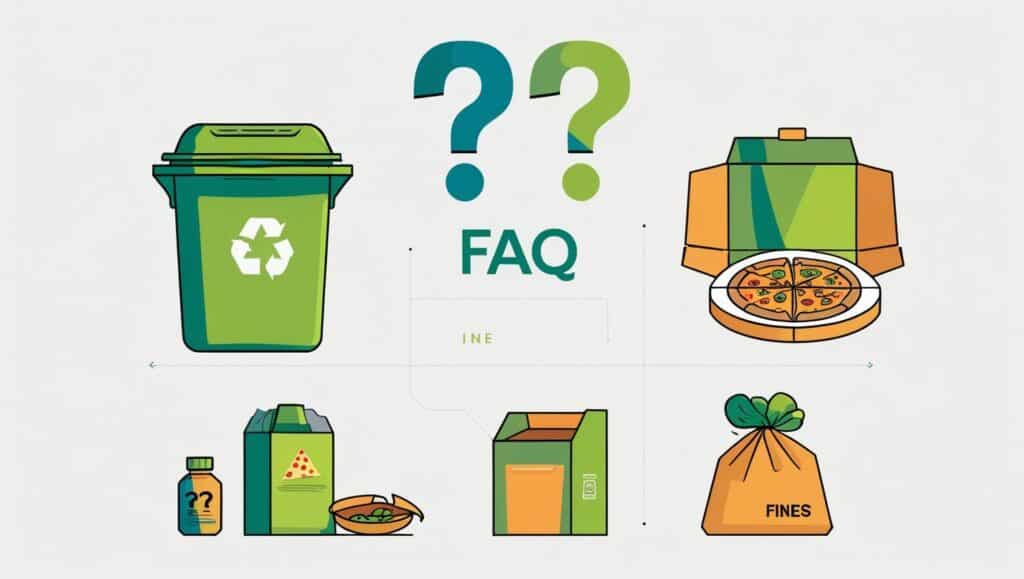
What exactly counts as food scraps under SB 1383?
Under California’s SB 1383 law, food scraps include any leftover food that would normally be thrown away. This covers fruit and vegetable peels, coffee grounds, eggshells, bread, dairy, cooked food, spoiled produce, and even small amounts of meat and bones. Basically, if it was once edible, it should go into the green bin instead of the trash. This helps keep organic waste out of landfills and turns it into compost or renewable energy.
Can I be fined for not using the green bin?
Yes, eventually fines can be issued if households or businesses consistently fail to follow SB 1383 rules. However, enforcement usually starts with reminders, outreach, and education before penalties are applied. Cities and counties want people to learn the system first, not get punished immediately. Once fines do apply, they vary depending on the violation and whether it’s a home, apartment, or business.
Do apartments have to provide green bins in California?
Yes, multi-family apartments and condos are required under SB 1383 to provide access to green bins for residents. Property owners and managers must set up separate bins for organic waste, recycling, and trash, and also educate tenants on how to use them correctly. If you live in an apartment, your building should already have or soon provide these bins.
Can greasy pizza boxes and napkins go in the green bin?
Yes! Greasy pizza boxes, used paper napkins, and food-soiled paper like burger wrappers are all considered organic waste under SB 1383. Since these items are contaminated with food, they can’t be recycled in the blue bin, but they can safely break down in the green bin. This makes composting much easier and prevents contamination of the recycling stream.
Are compostable bags really allowed in California?
Yes, certified compostable bags that meet ASTM D6400 standards are allowed in California green bins. Many cities even encourage using them to collect kitchen scraps because they reduce mess and odor. However, not all plastic-looking bags are compostable, so always check for proper labeling. Regular plastic bags are never allowed in the green bin.
What are the bin colors under SB 1383?
SB 1383 sets a standardized color system across California: Green for organics (food and yard waste), Blue for recyclables (paper, cardboard, glass, cans), and Gray or Black for landfill trash. These consistent colors make it easier for residents and businesses to separate waste correctly, no matter which city or county they’re in.
Is there a grace period before fines?
Yes, most cities and counties have a grace period before fines begin. The first phase focuses on educating residents and businesses about how to sort waste correctly. Local governments usually provide reminders, written notices, or even free resources to help people adjust. Fines only kick in after repeated violations, ensuring everyone has time to understand the system.
Why Neighbors Argue Over Trash Bins (The Human Side)
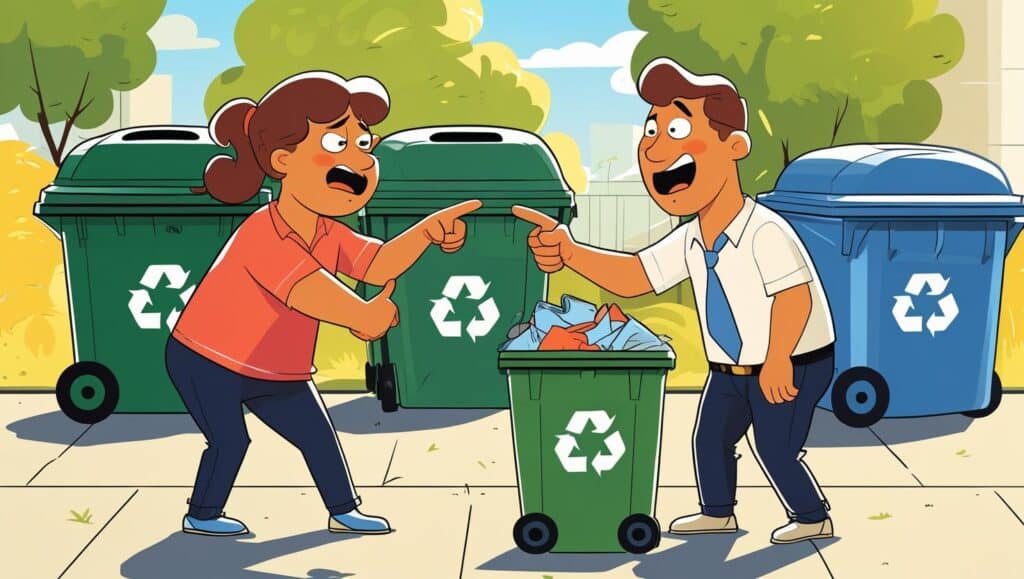
Let’s be honest — half of the neighborhood wars in America don’t start over fences or lawns… they start over trash bins 🗑️.
You’ve probably seen it: one neighbor leaves the bin out an extra day, another drags it back angrily, and suddenly the whole block feels like a courtroom.
- HOA Complaints: Homeowners Associations (HOAs) are famous for their “trash rules.” Leave your bin visible for 5 minutes too long, and you’ll find a friendly (ahem) notice in your mailbox.
- The Trash Police: Not actual cops, but every neighborhood has that one person who acts like they’re sworn into the Department of Sanitation Enforcement. They’ll remind you — loudly — that “trash pickup is only on Tuesdays!”
- Passive-Aggressive Notes: From sticky notes on lids (“This is not YOUR bin!”) to full-on typed letters taped to your garage door, trash disputes often come with creative writing exercises.
Why does this happen? Because trash bins aren’t just bins — they’re a weird symbol of shared space and personal responsibility. When someone messes up the system, others feel like their own order is being disturbed.
It’s human, it’s silly, and sometimes it escalates way too far. But if you’re fighting with your neighbor over a bin, remember: it’s not really about the plastic can — it’s about boundaries, respect, and sometimes just a dash of neighborhood drama.
Quick Checklist – How to Stay SB 1383 Compliant at Home
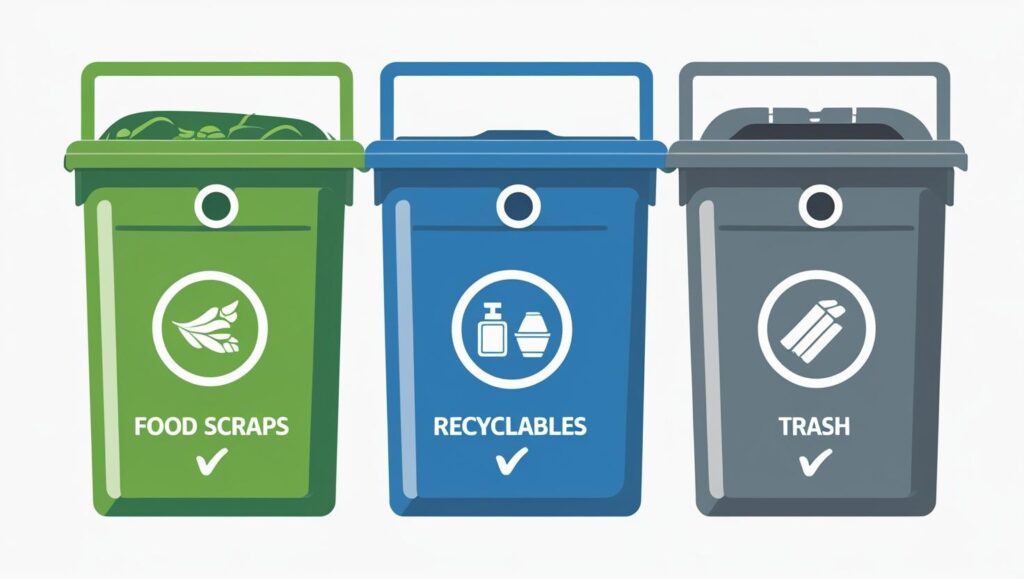
Staying compliant with California SB 1383 doesn’t have to be stressful. In fact, once you set up a simple routine, it becomes second nature. Here’s a handy checklist you can follow at home:
✅ Know your bin colors – Most cities use green for organic waste, blue for recycling, and black/gray for landfill. Double-check your local hauler’s guide, because colors can sometimes vary.
✅ Use your kitchen pail – Many counties provide a free countertop pail for food scraps. Keep it near your sink to collect peels, leftovers, and coffee grounds. Once full, empty it into your green bin outside.
✅ Keep a scrap list on the fridge – Not sure if pizza boxes or eggshells belong in organics? A quick “what goes where” list can save confusion for the whole family. Some cities even give printable guides you can tape right on the fridge.
✅ Expect warnings first, not instant fines – Don’t panic! SB 1383 enforcement usually starts with friendly reminders and contamination tags. Cities want to help residents form the right habit before moving to penalties.
👉 Following this checklist makes it easier to avoid mistakes and keeps your household aligned with state law — without stress.
Final Thoughts – Turning Trash Into Climate Action
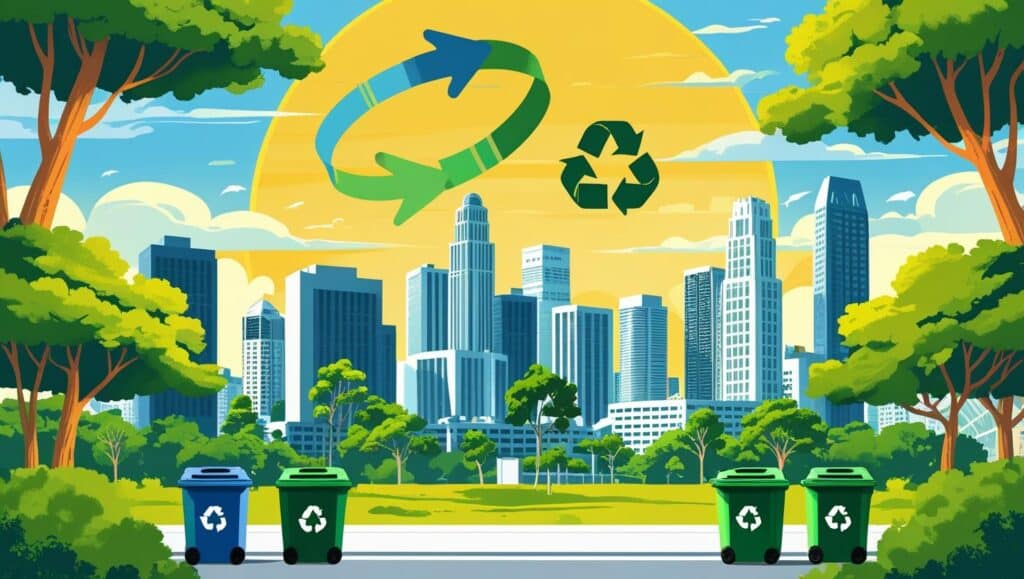
At first glance, California’s new organic waste law might seem like it’s just about sorting trash. But in reality, it’s a climate action plan wrapped inside your green bin. By keeping food scraps and yard waste out of landfills, the state is tackling methane emissions head-on — one of the biggest drivers of climate change.
If the rules still feel confusing, don’t worry. Once you’ve tossed your first pizza box or coffee filter into the green bin, the rest quickly becomes second nature. Think of it less as a complicated regulation and more as a simple habit — like buckling your seatbelt or carrying a reusable bag.
And here’s the inspiring part: every banana peel, every coffee ground, every soggy napkin you compost is quietly working for the planet. From your kitchen counter to your curbside bin, these small actions add up to a cleaner California and a cooler climate.
So the next time you wonder where that half-eaten sandwich should go, remember: from pizza boxes to coffee grounds, your green bin is California’s quiet climate hero. 🌍💚
